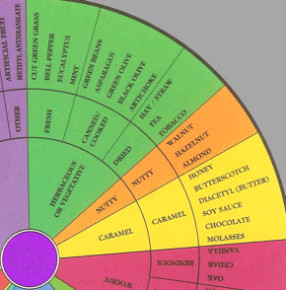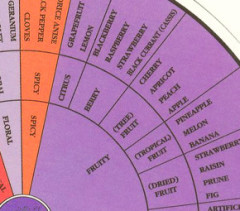The Wine Aroma Wheel Goes Round & Round.
Chapter Three, Part Eight.
I‘m writing this blog under protest. I’m protesting the intolerable conditions in this frigid basement office where my breath fogs the screen and I have to sip whiskey to keep my spleen from developing potholes. Luckily this is in keeping with my new diet. I’m on the bourbon diet and I’ve already lost 300,000 brain cells.
It was 12 degrees this morning but at least the Weather Channel reports it’s going to cool down soon. My friend visited from Arizona and when he complained about the cold I said, “Hey, this isn’t so bad. It’s a dry cold.”
The household has finally adjusted to the arctic temperatures. My son has actually pulled his pants up and my wife happily fuels the fireplace with my old articles.
Speaking of old articles, last week’s blog described the “stream of consciousness” that takes place when you attempt to identify a taste that’s difficult to pin down, even when it’s on the tip of your tongue – literally. The same thought progression takes place when you’re trying to put a name to a familiar aroma.
When Ann C. Noble was professor of Viticulture and Enology at the University of California at Davis, she created a visual aid called the wine aroma wheel. The wheel illustrates the thought progression that happens when you focus on increasingly specific aromas.
I wrote to Noble in 2010 and she explained that, “Novice tasters often complain that they “cannot smell anything” or can’t think of a way to describe the aroma of wine. Fortunately, it is very easy to train our noses and brains to connect and quickly link terms with odors.”
The wine aroma wheel helps our brains make these associations and then fine-tune our observations into more precise descriptions. The center of the wheel lists several generic aromas often found in wine. As you read from the center to the outside of the wheel the terms increase and grow more specific.
Imagine you detect an aroma that reminds you of fruit but you’re not sure what type of fruit you’re sensing. Search the innermost circle of the wine aroma wheel for an entry called ‘fruity’ and follow it out to the second circle. This level breaks fruity into categories labeled citrus, berry, tree fruit, tropical fruit, dried fruit and other. If you decide the fruit you perceive is from the tree fruit grouping, the third ring further divides into specific subcategories called cherry, apricot, peach and apple.
The wine aroma wheel doesn’t have a fourth ring, but you can project these aromas into even more specific fragrances. For example apple could be whittled down to green apple, yellow apple, Granny Smith, Macintosh, Delicious or even apple cider (which should be listed under wine defects). Cherry could be further classified into Bing cherry, Maraschino cherry, or black cherry. When cherry and chocolate flavors combine, you’ve got Cherry Garcia ice cream (which I keep here on my desk so it won’t melt).
I haven’t used my wine aroma wheel lately because the brutal cold has seriously curtailed my wine consumption. I once read the optimum temperature for drinking white wine is 50 to 55 degrees, so at this rate I won’t get a drink until late April. They say abstinence never killed anybody but I say why take that chance.
You can obtain a color, laminated wine aroma wheel from www.winearomawheel.com.
























